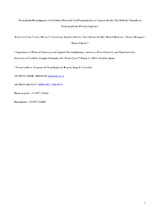Hemoglobin bioconjugates with surface-protected gold nanoparticles in aqueous media: The stability depends on solution pH and protein properties
Autor
Del Caño-Ochoa, Rafael
Mateus, Lucía
Sánchez-Obrero, Guadalupe
Sevilla, José Manuel
Madueño, Rafael
Blázquez, Manuel
Pineda, Teresa
Editor
ElsevierFecha
2017Materia
HemoglobinGold nanoparticles
Protein corona
UV–visible spectroscopy
Attenuated total reflectance infrared spectroscopy
Dynamic light scattering
Zeta-potential
METS:
Mostrar el registro METSPREMIS:
Mostrar el registro PREMISMetadatos
Mostrar el registro completo del ítemResumen
The identification of the factors that dictate the formation and physicochemical properties of protein-nanomaterial bioconjugates are important to understand their behavior in biological systems. The present work deals with the formation and characterization of bioconjugates made of the protein hemoglobin (Hb) and gold nanoparticles (AuNP) capped with three different molecular layers (citrate anions (c), 6-mercaptopurine (MP) and -mercaptoundecanoic acid (MUA)). The main focus is on the behavior of the bioconjugates in aqueous buffered solutions in a wide pH range. The stability of the bioconjugates have been studied by UV-visible spectroscopy by following the changes in the localized surface resonance plasmon band (LSRP), Dynamic light scattering (DLS) and zeta-potential pH titrations. It has been found that they are stable in neutral and alkaline solutions and, at pH lower than the protein isoelectric point, aggregation takes place. Although the surface chemical properties of the AuNPs confer different properties in respect to colloidal stability, once the bioconjugates are formed their properties are dictated by the Hb protein corona. The protein secondary structure, as analyzed by Attenuated total reflectance infrared (ATR-IR) spectroscopy, seems to be maintained under the conditions of colloidal stability but some small changes in protein conformation take place when the bioconjugates aggregate. These findings highlight the importance to keep the protein structure upon interaction with nanomaterials to drive the stability of the bioconjugates.

